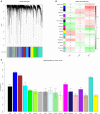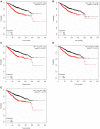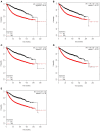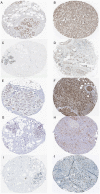Prognostic Genes of Breast Cancer Identified by Gene Co-expression Network Analysis
- PMID: 30254986
- PMCID: PMC6141856
- DOI: 10.3389/fonc.2018.00374
Prognostic Genes of Breast Cancer Identified by Gene Co-expression Network Analysis
Abstract
Breast cancer is one of the most common malignancies. The molecular mechanisms of its pathogenesis are still to be investigated. The aim of this study was to identify the potential genes associated with the progression of breast cancer. Weighted gene co-expression network analysis (WGCNA) was used to construct free-scale gene co-expression networks to explore the associations between gene sets and clinical features, and to identify candidate biomarkers. The gene expression profiles of GSE1561 were selected from the Gene Expression Omnibus (GEO) database. RNA-seq data and clinical information of breast cancer from TCGA were used for validation. A total of 18 modules were identified via the average linkage hierarchical clustering. In the significant module (R2 = 0.48), 42 network hub genes were identified. Based on the Cancer Genome Atlas (TCGA) data, 5 hub genes (CCNB2, FBXO5, KIF4A, MCM10, and TPX2) were correlated with poor prognosis. Receiver operating characteristic (ROC) curve validated that the mRNA levels of these 5 genes exhibited excellent diagnostic efficiency for normal and tumor tissues. In addition, the protein levels of these 5 genes were also significantly higher in tumor tissues compared with normal tissues. Among them, CCNB2, KIF4A, and TPX2 were further upregulated in advanced tumor stage. In conclusion, 5 candidate biomarkers were identified for further basic and clinical research on breast cancer with co-expression network analysis.
Keywords: GEO; TCGA; breast cancer; prognosis; weighted gene co-expression network analysis (WGCNA).
Figures










Similar articles
-
Identification of five hub genes as monitoring biomarkers for breast cancer metastasis in silico.Hereditas. 2019 Jun 21;156:20. doi: 10.1186/s41065-019-0096-6. eCollection 2019. Hereditas. 2019. PMID: 31285741 Free PMC article.
-
Identification of Prognostic Candidate Genes in Breast Cancer by Integrated Bioinformatic Analysis.J Clin Med. 2019 Aug 2;8(8):1160. doi: 10.3390/jcm8081160. J Clin Med. 2019. PMID: 31382519 Free PMC article.
-
Systematic prediction of key genes for ovarian cancer by co-expression network analysis.J Cell Mol Med. 2020 Jun;24(11):6298-6307. doi: 10.1111/jcmm.15271. Epub 2020 Apr 21. J Cell Mol Med. 2020. PMID: 32319226 Free PMC article.
-
Emerging Biomarkers in Bladder Cancer Identified by Network Analysis of Transcriptomic Data.Front Oncol. 2018 Oct 12;8:450. doi: 10.3389/fonc.2018.00450. eCollection 2018. Front Oncol. 2018. PMID: 30370253 Free PMC article. Review.
-
Identification of Biomarkers for Breast Cancer Using Databases.J Cancer Prev. 2016 Dec;21(4):235-242. doi: 10.15430/JCP.2016.21.4.235. Epub 2016 Dec 30. J Cancer Prev. 2016. PMID: 28053957 Free PMC article. Review.
Cited by
-
METTL16 regulates the mRNA stability of FBXO5 via m6A modification to facilitate the malignant behavior of breast cancer.Cancer Metab. 2024 Jul 25;12(1):22. doi: 10.1186/s40170-024-00351-5. Cancer Metab. 2024. PMID: 39061113 Free PMC article.
-
Transcriptome Analysis Identifies Novel Prognostic Genes in Osteosarcoma.Comput Math Methods Med. 2020 Oct 6;2020:8081973. doi: 10.1155/2020/8081973. eCollection 2020. Comput Math Methods Med. 2020. PMID: 33082842 Free PMC article.
-
Genome-wide identification and characterization of the bHLH gene family and analysis of their potential relevance to chlorophyll metabolism in Raphanus sativus L.BMC Genomics. 2022 Aug 1;23(1):548. doi: 10.1186/s12864-022-08782-4. BMC Genomics. 2022. PMID: 35915410 Free PMC article.
-
Prioritization of Diagnostic and Prognostic Biomarkers for Lupus Nephritis Based on Integrated Bioinformatics Analyses.Front Bioeng Biotechnol. 2021 Oct 8;9:717234. doi: 10.3389/fbioe.2021.717234. eCollection 2021. Front Bioeng Biotechnol. 2021. PMID: 34692653 Free PMC article.
-
Pathological stage-associated non-coding RNA long intergenic non-protein coding RNA 1234 (LINC01234) participation in cell cycle regulation in adrenocortical carcinoma through bromodomain-containing protein 4 (BRD4) expression mediation via sponging microRNA (miR)-140-3p.Bioengineered. 2022 May;13(5):13607-13621. doi: 10.1080/21655979.2022.2081464. Bioengineered. 2022. PMID: 35765893 Free PMC article.
References
LinkOut - more resources
Full Text Sources
Other Literature Sources
Miscellaneous

